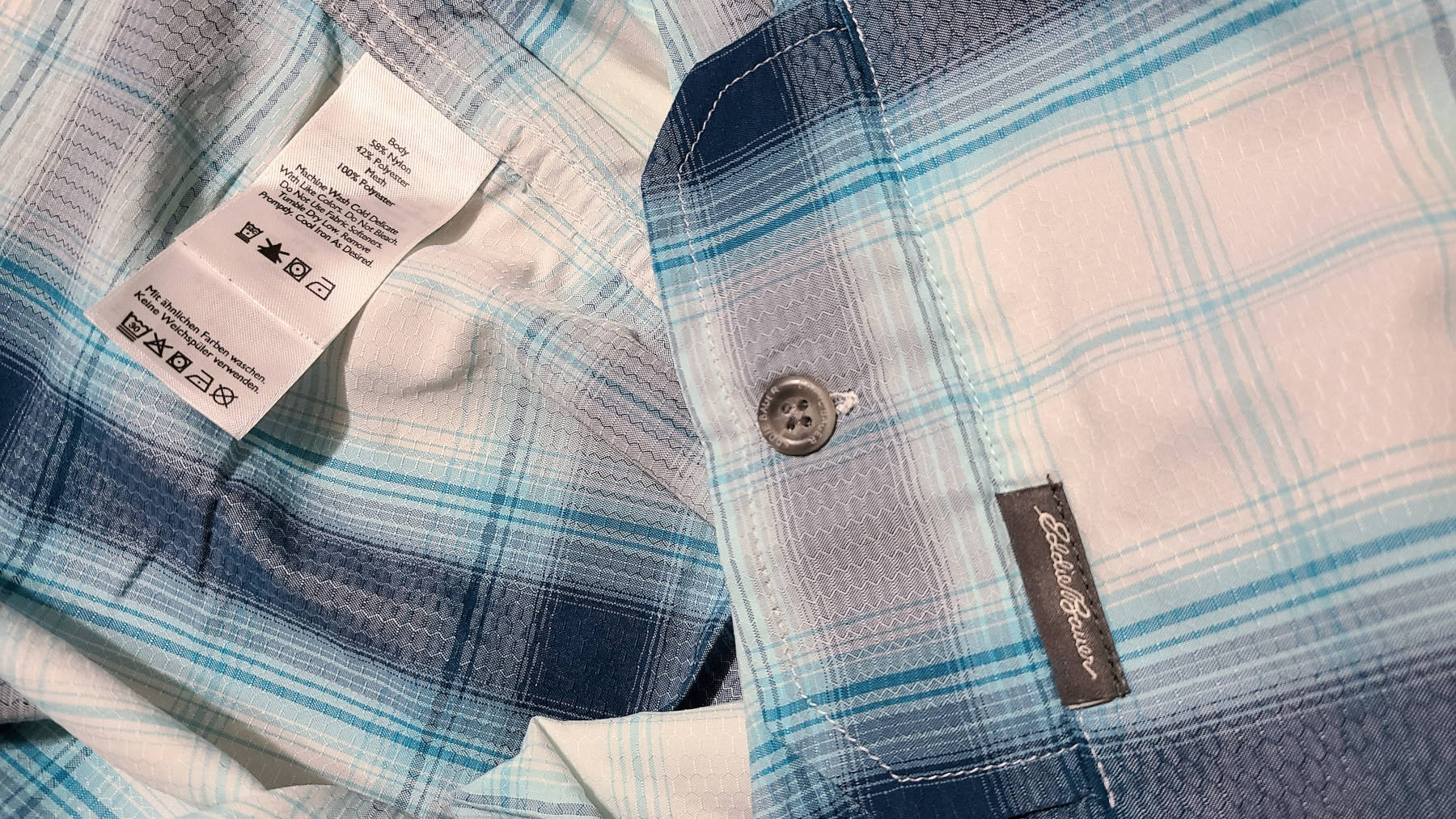The right outdoor gear can make or break your plans, which is why we take the time to do the research, providing you with the best information to choose the most reliable outdoor gear.
Today, let’s take a closer look at polyester for hiking, whether it is used in clothing or gear, how it differs from other fabrics like nylon, and our research-based choice on using the material when planning a day hike.

For the sake of clarity, we should address some basic tenants of hiking. While not all hikers will experience the following situations, most will somehow or another regardless of age, gender, trail location and difficulty.
The first of these is sweat. No matter the conditions, you will sweat some when hiking, which is your body’s natural response to exertion.
The body is trying to regulate your temperature, which is rising because of your performing exercise… a natural function.
However, sweat can be uncomfortable if not evaporated in warmer climates, and it can be dangerous in cold climates. Evaporating sweat can cool your body, which is not ideal when you are trying to stay warm.
The second constant of hiking is exposure to sunlight. This may be the reason you are outside hiking, trying to get out from the dark tucked away office cubicle. Sunlight offers positive benefits such as Vitamin D but also can provide some health concerns.
Prolonged exposure to UVA and UVB rays from the sun can contribute to skin aging and other skin issues, including skin cancer.
So let’s find out if polyester good for hiking…
What is Polyester?
Polyester is a man-made fabric. In the early 1940s, it was discovered that certain acids and ethyl alcohols could be mixed to make a fiber.
Like cotton fibers, they could be woven into sheets to make virtually any clothing article made by its organic predecessor. The process for making these fibers may sound familiar because it is how most general plastics are made.
Look on the bottom of clear plastic food or drink containers, and you will likely find the recycle symbol with the number 1 inside. Underneath will be written PET.
This is essentially the same material as polyester fibers, just utilized in a different way.
In fact, some polyester clothing is made from recycled plastic bottles, but more on that later. It is important to note that many polyester clothing options are not truly 100% polyester.
Most times, polyester will be blended with nylon or spandex to harness the properties of those materials.
Advantages of Polyester
Is Polyester Good for Summer
One main advantage of polyester is that it excels at moisture-wicking making it a great summer hiking option. This feature is vital in hot temperatures because it keeps your skin dry, and the evaporation process will keep you cool, making polyester an ideal breathable clothing choice.
Moisture-wicking is a buzzword in the clothing and advertising industry, and you will often see it listed as a feature of outdoor clothing.
Which Type of Fabric Dries the Fastest?
If you happen to get your polyester clothing completely wet, it will dry out fairly quickly, much faster than cotton would.
Having a fast-drying and moisture-wicking material is important in the fight against chafing while hiking.
Chafing and blisters occur when there is constant rubbing between skin, material, and more skin.
This problem can be compounded when skin or material is wet, so the faster your clothing and skin dries off, the less likely it will occur.
Protection From The Sun
Another standout point for polyester is its defense against the sun’s UV rays. Typically, polyester is woven in a very tight pattern.
This tight-knit weave lets very little light through, which keeps your skin safe.
Polyester is easily dyed, which produces two effects. The first is that it can be dyed lighter colors to reflect light. Certain dye types (of the same color) can further protect against UV rays than regular dyes.
The second advantage of the ease of dying is that you can purchase your hiking clothes in almost any color imaginable.
I don’t know about you, but I aim for function but hope to be fashionable at the same time. Bright colors are a good choice for hikers; it makes you easy to spot in case of an emergency.
Is Polyester Warm
When it comes to staying warm, the moisture-wicking properties of polyester and the ability to easily layer polyester make it a better choice for hiking in colder weather.
When you wear multiple layers in colder weather, a polyester base layer will move the sweat away from your skin.
This prevents your body from experiencing the effects of evaporation, which can be dangerous when trying to maintain body heat in freezing temperatures.
In addition, polyester can be blended with other fabrics to make much warmer clothing than things made just of cotton.
Polyester is suitable for hiking and outdoor activities because of how lightweight it is. Heavy and thick materials such as cotton are the bane of the hiker.
If you are packing clothes to travel, or even for an extended hiking trip, items like polyester hiking pants will not take up much space or weight compared to cotton.
Nylon vs Polyester Clothing
In short, the answer is up to personal preference. There are many benefits of polyester, and the same goes for nylon. Nylon will be thicker and a different texture, offering a varied selection of benefits.
However, our preference is a mixture of both.
A positive property of polyester is its ability to be blended with other materials. It can be mixed with nylon for a softer and stronger overall construction.
To make the material more “stretchy”, polyester can be intermixed with small amounts of spandex. Check the tag of your clothing items to see what they are made of.
Lastly, an advantage of this miracle material is its price. It is mass-manufactured very easily and therefore inexpensive.
Do not be fooled by high price tags on polyester big brand name clothes; most of the money you are paying is for the logo. You can often get very similar products for much lower prices, just without the symbol of the Greek god of victory.
What Are the Disadvantages of Polyester?
While there are many reasons to love polyester, there are some downsides to this fabric worth considering. The first of these is a long-standing complaint about the feel. For decades, many people have disliked the way that polyester feels against their skin.
Those who have higher dermal sensitivity will likely find polyester materials scratchy or itchy, all-around uncomfortable.
If you are in that category, then polyester would not be a good candidate for walking many miles!
While this problem is common, polyester can become softer and less likely to irritate the skin when blended. Look for blended materials for a rash-reducing remedy. Secondly, polyester clothing has a reputation for being smelly.
This is because of its moisture-absorbing properties.
While this is an excellent trait to have when dealing with water, which evaporates, sweat also contains natural oils from the body. These, unfortunately, do not evaporate like water does, leaving them in the fabric.
After hours of this process repeating itself, the polyester cloth can become rather inundated with stinky oils.
Fortunately, washing polyester will remove most of the smells. Lastly, the flammability of polyester is a definite downside. Pure polyester clothes are naturally flammable, and care should be taken to avoid their proximity to open flames.
Most of the time, this can be avoided, but it is something to be aware of.
Is Polyester Sustainable?
A common concern raised about polyester is that it is not environmentally sound or sustainable. Both statements are true, and since it is made-made “plastic”, it falls into the category of plastic bottles and bags, which have unfortunate byproducts when created.
They also do not decompose very quickly, making them very difficult to dispose of them in an ecologically sound way.
The good news is that, as mentioned before, they can be made of recycled plastics.
More and more companies like Patagonia are making clothing from recycled plastic bottles and other materials, reducing the impact these non-renewable resources have on the environment.
Of course, there is a higher price tag on these items, but many consider it worthwhile when weighing the cost of protecting our planet.
Our Verdict on Polyester for Your Hiking Clothes?
Overall, polyester is a great choice when choosing attire for your hiking activities. Since polyester blends well with other fabrics, you have various options that will feel great against your skin, properly fit your body type, and offer fashionable colors.
Most importantly, you will stay dry since polyester works to wick the moisture away from your body.
Choosing the right hiking gear for your adventure begins with understanding the advantages and disadvantages of fabric and making sure it is right for you!
